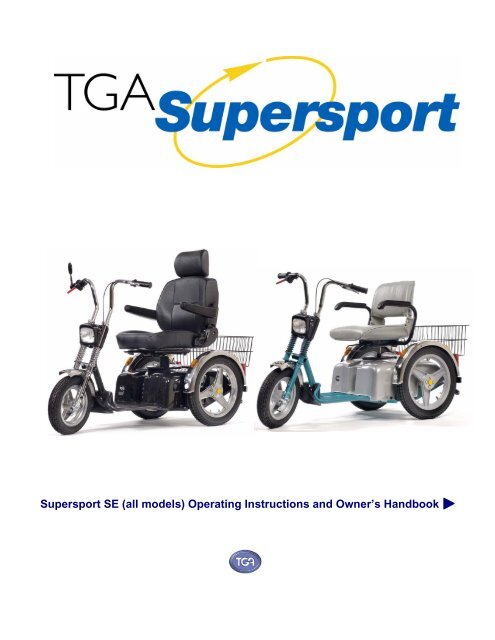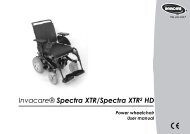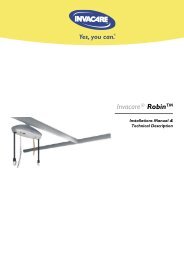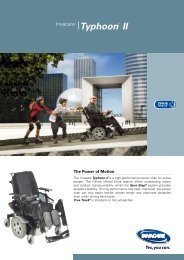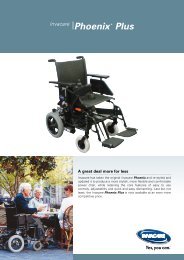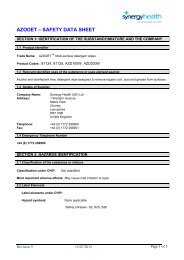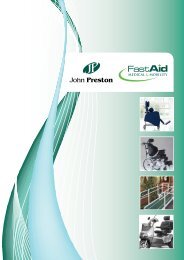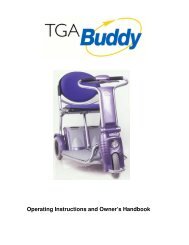TGA Supersport Manual - Value Mobility Scooters
TGA Supersport Manual - Value Mobility Scooters
TGA Supersport Manual - Value Mobility Scooters
Create successful ePaper yourself
Turn your PDF publications into a flip-book with our unique Google optimized e-Paper software.
<strong>Supersport</strong> SE (all models) Operating Instructions and Owner’s Handbook
CONTENTS<br />
1. INTRODUCTION ................................................................................................ 2<br />
2. ASSEMBLY...................................................................................................... 3<br />
3. PREPARE THE SUPERSPORT FOR FIRST USE...................................................... 4<br />
4. THE CONTROLS AND INSTRUMENT PANEL.......................................................... 4<br />
5. SEAT ADJUSTMENT ......................................................................................... 5<br />
6. DRIVING.......................................................................................................... 6<br />
7. TRANSPORTING SUPERSPORT .......................................................................... 7<br />
8. PARKING BRAKE RELEASE............................................................................... 7<br />
9. SAFETY OVERLOAD SWITCH............................................................................. 7<br />
10. TIPS, CAUTIONS, PROBLEMS AND ADDITIONAL FEATURES................................ 7<br />
11. BATTERY CHARGING...................................................................................... 8<br />
12. A GUIDE TO SAFE AND LASTING BATTERIES.................................................... 8<br />
13. MAINTENANCE............................................................................................... 9<br />
14. TROUBLE SHOOTING.................................................................................... 10<br />
15. TECHNICAL SPECIFICATION .......................................................................... 11<br />
16. WARRANTY ................................................................................................. 11<br />
17. SAFE DRIVING TIPS FOR SCOOTER USERS ...................................................... 12
1. INTRODUCTION<br />
The <strong>Supersport</strong> – Outdoor Powered Scooter: Thank you for purchasing from <strong>TGA</strong>. We hope your <strong>Supersport</strong><br />
will bring much freedom and pleasure to your life.<br />
This handbook provides important information on the most common operational and maintenance concerns that<br />
the user should be familiar with. It is very important that the user is familiar with the driving technique and is able<br />
to operate the controls competently before venturing far from where there is assistance.<br />
The handbook will draw your attention to important safety related issues by Care! Warning Labeling. Keep this<br />
handbook for future referral.<br />
Care! Warning<br />
* Do not ride your <strong>Supersport</strong> without fully reading and understanding this instruction manual first.<br />
* Do not exceed the maximum gradient/slope of 12°.<br />
* Do not carry passengers (except vehicles purposely designed for this use on private land) or exceed the<br />
maximum carrying weight (see Technical Specifications).<br />
* Do not get on or off your <strong>Supersport</strong> unless it is switched off.<br />
* Do not switch your <strong>Supersport</strong> on with the speed control lever depressed.<br />
* Do not back your <strong>Supersport</strong> into uneven inclines or surfaces. Be cautious when traversing slopes.<br />
* Do not drive your <strong>Supersport</strong> in a confined space unless the speed adjustment is set to low.<br />
* Do not turn suddenly at full speed, especially on uneven or hilly ground. Failure to observe this may result<br />
in tipping of the scooter.<br />
* Do not drive your <strong>Supersport</strong> unless the seat is locked into the driving position.<br />
* Do not drive your <strong>Supersport</strong> over deep, soft terrain (e.g. soft dirt, deep grass, loose gravel).<br />
* Do not operate your scooter when under the influence of alcohol or certain drugs, which may impair your<br />
safety.<br />
* Do not climb or descend curbs that exceed the <strong>Supersport</strong>’s capability.<br />
* Do not turn when negotiating curbs. Always approach curbs at low speed and straight.<br />
* Always stop fully before changing direction (forward or reverse).<br />
* Always keep your feet on the vehicle when driving.<br />
* Always proceed carefully while riding your scooter, especially as you approach the downgrade of a ramp or<br />
hill.<br />
* Always proceed carefully while riding on uneven surfaces.<br />
* Do not sit on your <strong>Supersport</strong> while being transported in a moving vehicle. Always restrain the scooter so<br />
that it cannot move in the vehicle and transfer yourself to a vehicle seat.<br />
* Do not drive your <strong>Supersport</strong> through deep water or clean with a high pressure hose.<br />
* Never attempt to freewheel down a slope as all braking will be lost.<br />
* Safe driving tips for scooter users have been printed in the back of this manual. For your own safety and<br />
that of others please ensure that you thoroughly read and understand this and in addition always obey the<br />
rules of the road.<br />
2
Intended Purpose<br />
The <strong>Supersport</strong> is intended for outdoor use and is fitted with large wheels making it ideal for rough terrain and<br />
cross country as well as normal use. It is capable of climbing slopes up to 21% (see technical specification) and<br />
negotiating obstacles up to 12cm. Care must be taken when using in these conditions.<br />
Pavement Use<br />
The speed of the <strong>Supersport</strong> is dependant on the weight of the occupant, incline and the type of surface. Tested<br />
with a weight of 18 stone (114.55kg) the <strong>Supersport</strong> had a speed of 7.5/8mph on the flat, on high speed setting.<br />
When used on the pavement, the UK law limits the speed to 4mph. For pavement use make sure 4mph is selected,<br />
and drive with care.<br />
2. ASSEMBLY (WHERE NECESSARY)<br />
The <strong>Supersport</strong> was pre-delivery inspected and tested prior to dispatch. The batteries may have been disconnected<br />
for delivery purposes only.<br />
Remove all the items from the carton and strip the protective packaging materials off each item. Returns are only<br />
accepted when the product is shipped in the original cartons with the original packing material installed.<br />
<strong>Supersport</strong> will have had the front wheel and the seat removed. Replace the front wheel and mudguard into the<br />
forks using the components supplied. Ensure the wheel nuts are securely tightened.<br />
1.2<br />
1.5<br />
1.2<br />
1.4<br />
1.1<br />
1.3<br />
Removal and Replacement of Deluxe seat – To remove seat,<br />
release the seat locking lever, at front of seat, and turn seat through<br />
180° so that it faces to the rear. Now lift seat straight up and out.<br />
Replacing the seat is just a reversal of the above.<br />
Removal and Replacement of Standard seat – To remove seat<br />
release the seat locking lever at front of seat, fig 1.1, and lift the seat<br />
straight up. Replacing the seat is just a reversal of the above.<br />
Fig. 1<br />
Rear Cover Removal – Remove seat, then unscrew the four black<br />
fixing screws located at the top rear and side of the cover (fig 1.2).<br />
Remove cover. Replacement is just a reversal of the above, ensuring the<br />
cover locates correctly. If your <strong>Supersport</strong> is fitted with the rear basket<br />
then there will be a further two fixing screws holding the basket to the<br />
rear bumper which will need to be removed.<br />
Rear Cover Removal (wide and extra wide seat) –<br />
Release the seat locking lever found at the middle front<br />
under the seat fig 2 and carefully tilt the seat back.<br />
Remove cover as described in previous paragraph.<br />
Handlebars – These are individually adjustable for<br />
height and angle. Release the securing levers fig 1.3<br />
and set the handlebars to your preferred height and<br />
angle. Re-tighten securing levers. The controls are on<br />
the right hand bar, however left hand controls are<br />
available. If you have the <strong>Supersport</strong> with extra wide<br />
seat, one handlebar will be shorter than the other, to<br />
allow for offset driving position.<br />
Fig. 2<br />
2.1<br />
Batteries – For safety in transit the main supply leads may have been disconnected from the batteries. The black<br />
lead would have been disconnected from one battery and the red lead from the other. These will be taped to the<br />
batteries in an obvious position as will the fixing bolts. Simply reconnect the leads ensuring the bolts are correctly<br />
tightened.<br />
3
3. PREPARE THE SUPERSPORT FOR FIRST USE<br />
If you receive your <strong>Supersport</strong> packaged and it has to be assembled see the section covering Assembly. The<br />
batteries will require charging - refer to Charging the <strong>Supersport</strong> for details.<br />
Care! Warning<br />
The <strong>Supersport</strong> is easy to drive but it is essential that you familiarise yourself with the controls and learn to drive it<br />
in a safe area with sufficient room to maneuver for your safety and that of others. The area should be free of<br />
obstacles and reasonably flat. Mark a practice course for straight line driving, turning in confined spaces, reversing<br />
and driving around obstacles.<br />
4. THE CONTROLS AND INSTRUMENT PANEL<br />
Figs 3-6 Provide details of the control system. Listed below are the various controls and their uses.<br />
1. Speed Control Levers - The speed of <strong>Supersport</strong> is controlled by the red<br />
lever located on the right hand handlebar and shown in Fig 3.1. Always use<br />
the lever gently, remembering that the more you squeeze the lever in the<br />
quicker you will go. To stop simply release the lever, the braking is<br />
completely automatic and when the machine has stopped the parking brake<br />
will engage and stay on until the machine moves off again. You may have a<br />
machine that has been fitted with the following factory fitted option:-<br />
a) L/H speed Control Lever - This is used exactly as described above and is<br />
fitted to the L/H handlebar instead of R/H<br />
2. Emergency Brake - All braking on the <strong>Supersport</strong> is automatic and the<br />
emergency brake should never need to be used. It is only for emergency in the<br />
very unlikely event that the automatic braking fails. The lever is located on left<br />
handle bar (fig 4.1). If your machine has been fitted with the L/H speed<br />
control lever, then the emergency brake will be fitted to the R/H handlebar.<br />
3.4<br />
3.2<br />
3.3<br />
Fig 3<br />
4.1<br />
3.1<br />
3. Horn – Button located on R/H side of handlebar (fig 3.2). The buzzer can<br />
also be configured to automatically sound when using driving in reverse (this<br />
function is deactivated as standard).<br />
Fig 4<br />
4. Indicators - Left and right hand located on the R/H handlebar. Push the switch in the same direction as you<br />
need to turn. To stop the indicators, return button to central location (fig 3.3).<br />
5. Hazard Warning Lights - Operates all indicator lights together and for emergency use only. The button is<br />
located on the side of headlight. Press button to operate. Press again to switch off (fig 5.1).<br />
6. Head Light Switch - This switches on front and rear lights, and located at fig 5.2. Lights will reduce range of<br />
scooter. Use only when necessary.<br />
7. Power On/Off Switch - This has a removable key which should be taken out when machine not in use.<br />
When the key is inserted the switch has two positions, “off” where there will be no power to the machine and the<br />
parking brake will be engaged and “on” where the machine is ready for use (fig 5.4). If <strong>Supersport</strong> is<br />
inadvertently left switch on, after a certain period of time it will shut itself down to conserve battery. To restart,<br />
turn the key to off, wait a few seconds and turn on again.<br />
8. On Light – Will come on green when the key is turned to on and <strong>Supersport</strong> ready for use (fig 6.1). This light<br />
is also used as a fault indicator and if it is flashing Red/Green it is showing the <strong>Supersport</strong> to either have a fault or<br />
the parking brake release lever has been activated.<br />
4
9. Forward/Reverse Switch – Located on the RH handlebar (fig 3.4). Select your desired direction by pressing<br />
either side of switch as marked. When using reverse the top speed is automatically reduced and a warning buzzer<br />
will sound (please note the reverse buzzer is deactivated as standard). WARNING Always come to a complete<br />
stop before changing selector switch.<br />
10. Speed Selector Switch – This is located on the LH side of headlamp (fig 5.3).<br />
It has two positions, ‘up’ is the high speed (approx 8 mph) and ‘down’ is the slow<br />
speed (approx 4mph). CARE WARNING – It is a legal requirement not to exceed 4<br />
mph on footpaths or shopping areas. Always use the slow speed when driving inside<br />
buildings, crowded areas, sales, stately homes etc. Using the faster speed in these<br />
sort of conditions presents a serious danger both to yourself and people on foot.<br />
Don’t forget these machines are very quiet and others may not be aware of your<br />
presence. The 8 mph speed is only legal for road or off road use. ALWAYS COME TO<br />
A STOP BEFORE CHANGING SPEED.<br />
5.4<br />
5.2<br />
Fig 5<br />
5.1<br />
5.3<br />
11. Battery Condition Indicator (Fig 6) – Located on top of the headlamp and indicates the capacity of the<br />
battery. When the indicator is as far to the right as possible shows the battery to be fully charged. It will<br />
gradually move across to the left as the battery power gets used.<br />
When it reaches the middle you should start thinking about<br />
recharging, and when it reaches the last 2 or 3 divisions it is<br />
important to get it on charge as soon as possible. At this point<br />
there may only be one or two miles left. It is impossible to be<br />
more specific than this as every rider and different types of<br />
terrain will achieve different results. It is important to only use<br />
<strong>Supersport</strong> on short runs to start with to explore the sort of range<br />
you will be achieving. Then when you are confident about range,<br />
start going on longer journeys.<br />
5. SEAT ADJUSTMENT (STANDARD SEAT)<br />
1. For ease of entry and exit to <strong>Supersport</strong> the seat will swivel to the left or right. The lever is located at the front<br />
of the seat (fig 1.1). Make sure the seat locks in before either getting on or off, or driving.<br />
2. Armrests can be raised or lowered allowing easier entry and exit.<br />
3. The seat height is adjustable by altering the position of the seat stem. Remove the seat and rear cover and you<br />
will see the seat stem is held in its location by a single bolt. Remove the bolt and the seat stem can be adjusted<br />
up or down to any one of its fixing holes. Adjust to your preferred position and tighten bolt. Refit cover and seat<br />
(fig 1.4).<br />
SEAT ADJUSTMENT (DELUXE SEAT)<br />
1. For ease of entry and exit to <strong>Supersport</strong> the seat will swivel to the left or right. The lever is located at the front<br />
of the seat. Make sure the seat locks in before either getting on or off, or driving.<br />
2. The seat adjustment lever located at the front of seat allows the seat to be adjusted forward or backward.<br />
3. Backrest can be adjusted by releasing lever on LH side of seat.<br />
4. Armrests can be raised or lowered allowing easier entry and exit.<br />
5. Headrest can be made higher simply by pulling gently upward. To lower there is a small lever located on the<br />
top of the seat at the base of the left hand headrest support. Simply press the lever and adjust to preferred<br />
height.<br />
6. The seat height is adjustable by altering the position of the seat stem. Remove the seat and rear cover and you<br />
will see the seat stem is held in its location by a single bolt. Remove the bolt and the seat stem can be adjusted<br />
up or down to any one of its fixing holes. Adjust to your preferred position and tighten bolt. Refit cover and seat<br />
(fig 1.4).<br />
5<br />
Fig 6<br />
6.1
6. DRIVING<br />
Before driving make sure that the Battery is fully charged, check that the tyres do not appear to be soft, see<br />
Maintenance section for details of monthly checks and tyre pressures. Check that the Key is switched OFF before<br />
entry. When comfortably sat, ensure that the seat lever has locked the seat secure. Ensure that the armrests are in<br />
the down position.<br />
1. Set the <strong>Supersport</strong> speed to slow and switch on. Hold the handlebars with both hands and gently squeeze the<br />
right control lever to move the <strong>Supersport</strong> forward. The more you squeeze the lever, the faster you will go. Always<br />
come to a stop before changing H or L speeds, or forward and reverse.<br />
2. Releasing the control lever automatically operates the brakes to slow down and stop. Once stopped, the parking<br />
brake will automatically come on.<br />
3. Use the handlebars to steer.<br />
4. To go backwards, select reverse and squeeze the right control lever again. The speed in reverse is reduced<br />
automatically for safety.<br />
5. To negotiate from pavement to road, or road to pavement, you should try to find a suitable slope. The<br />
<strong>Supersport</strong> will mount, or go down kerbs 12cm high, but you should approach a kerb at right angles (90°). You<br />
should stop just short of the edge and:<br />
* If you are going up; select the high speed setting then drive until both front and back wheels are on the<br />
pavement, then immediately lower the speed.<br />
* If going down, proceed slowly on low setting until on the road, then switch to a suitable higher speed to<br />
cross the road safely.<br />
6. The <strong>Supersport</strong> is suitable for road use BUT great care must be taken and at the maximum speed of 8 mph, you<br />
may present a hazard to other faster moving road users. (See safe driving tips at the rear of this manual.)<br />
7. Watch your Battery Indicator. The distance you can travel depends on many factors, the more slopes, the less<br />
distance you can travel. We recommend that you gradually explore going further each day.<br />
8. Should the battery “run out” before you get home there are two things you can do to avoid being stranded.<br />
Stopping and switching off the KEY for 5 – 10 minutes will allow the battery to “recover” a little power so that you<br />
can proceed further. You can attempt this a number of times. If you are unfortunate and cannot return to home<br />
under the battery power there is a “Free Wheel” device that will allow someone to push the <strong>Supersport</strong> home (see<br />
Parking Brake Release).<br />
9. Range is influenced by many environmental conditions, hills will substantially decrease the range. Establish what<br />
you can obtain around your locality by gradually increasing the distance and checking the battery indicators at the<br />
end of each journey.<br />
10. Reducing the speed will also reduce the power. For climbing obstacles or hills you will need to increase the<br />
speed setting to give the power and then control the speed with the levers.<br />
Parking<br />
1. Before leaving the scooter, switch the ignition off, the battery indicator will then go off. Remove the ON/OFF<br />
Key for security.<br />
2. If the <strong>Supersport</strong> has been used in the Free Wheel mode (see Parking Brake Release), it is VERY IMPORTANT to<br />
re-engage the drive to ensure that the scooter brake is on before you alight.<br />
3. Flip up the armrest to make it easier to alight from the <strong>Supersport</strong>, or swivel the seat through 90 0 .<br />
6
7. TRANSPORTING SUPERSPORT – When transporting <strong>Supersport</strong> in a motor vehicle the height can be<br />
reduced by the removal of the seat the removal or lowering of the handlebars. Everything however must be<br />
securely strapped down including the scooter itself and anything removed from it. The user must never travel in a<br />
vehicle seated on <strong>Supersport</strong> but should transfer to a proper vehicle seat. CARE WARNING – All components are<br />
heavy, seek help if you think you may injure yourself when lifting.<br />
8. PARKING BRAKE RELEASE – The <strong>Supersport</strong> is fitted with a manual brake release. This is located at the<br />
rear right hand top of the cover, just behind the seat, fig 1.5. There will be no power to drive <strong>Supersport</strong> when<br />
the brake is in the off position and when switched on the ‘on’ light will come on but will flash indicating a fault<br />
mode. Never release this lever when <strong>Supersport</strong> is on a slope.<br />
9. SAFETY OVERLOAD SWITCH – The<br />
<strong>Supersport</strong> is protected electrically and<br />
electronically by 4 overload switches. They are<br />
designed to ‘pop-out’ should an overload or<br />
serious electronic fault occur. Possible examples<br />
that could cause the main overload switches to<br />
activate could be, steep or very long slope or high<br />
kerb causing overloading and overheating or<br />
possible accident damage.<br />
Two of the switches cover the main drive whilst<br />
one covers the lighting circuit and the other the<br />
charging circuit. These are located at the front of<br />
7.2<br />
the motor cover in the middle and directly behind<br />
your legs (fig 7.1). Should the main drive<br />
Fig 7<br />
7.1<br />
switches become activated for whatever reason<br />
they will cause a complete electrical shutdown and the parking brake will come on (fig 7.2). Switch off, allow a<br />
few minutes and push the button in to reset. If it will not reset, leave a few more minutes and try again. If it<br />
refuses to reset get in touch with your dealer. Never attempt to hold the button in by any other means. If the<br />
lights are not working or the machine will not charge, try the appropriate overload buttons. If they will not reset<br />
follow the instructions above (fig 7.3 and 7.4).<br />
7.5<br />
7.4<br />
7.2<br />
7.3<br />
10. TIPS, CAUTIONS, PROBLEMS AND ADDITIONAL FEATURES<br />
Stop Problems Before they Start - If you detect an unusual vibration or noise in the operation of your<br />
<strong>Supersport</strong>, try to determine the cause. Be sure the power is off before investigating. If you cannot discover the<br />
cause of a problem contact your dealer or <strong>TGA</strong> for help.<br />
Airline Checking - Sealed Lead Acid Batteries are permitted on most aeroplanes. A sticker on the battery case<br />
states what they are. Airline personnel may insist on removing the battery cover to verity its contents. It is best to<br />
check with the airline before hand. An airline compliance certificate is available from <strong>TGA</strong>, however it is up to the<br />
discretion of the individual airline regarding the transportation of items on their planes.<br />
Storage - Avoid storing your <strong>Supersport</strong> in locations with extreme heat or cold. A cool dry location is ideal if<br />
possible. The following steps will help keep rust and corrosion from impairing your scooters function and<br />
appearance. Turn the key to the off position. Clean all exterior surfaces, touch-up any damaged paint. Check and<br />
inflate the tyres to 35 PSI. Be sure the battery is fully charged before prolonged periods of storage and be sure to<br />
recharge every 6 weeks. Failure to comply may result in battery replacement.<br />
7
11. BATTERY CHARGING<br />
The battery charger supplied is special to your <strong>Supersport</strong> and so it may not be suitable for any other powered<br />
mobility product. Only use the charger supplied with your <strong>Supersport</strong> as other makes of chargers may permanently<br />
damage your batteries and would void the warranty.<br />
To charge your batteries follow these simple steps.<br />
1. Switch OFF your <strong>Supersport</strong> and remove the key.<br />
2. Plug the charger lead into the socket located in the middle of the front of the rear cover, fig 7.5. Plugging the<br />
charger into <strong>Supersport</strong> automatically cuts all power to the electronics and the scooter cannot be driven.<br />
3. Push the plug from the charger into a suitable wall outlet and switch on.<br />
4. The red light will come on for “mains on” as will an amber light indicating the battery is charging. Green will<br />
light when the batteries are fully charged.<br />
5. When the batteries reach their charged state, the charger will automatically stop charging. The lights will,<br />
however, still be on but the batteries cannot overcharge.<br />
6. Although to get out of trouble the batteries can be put on charge for a short period of time, it is always best to<br />
go through a complete charge cycle each time. Excessive short period charging will be detrimental to battery life.<br />
7. For the best results and to prolong battery life, try to run the battery down by at least 50% before recharging<br />
and in addition it is always best to go through a complete charge cycle each time.<br />
8. Depending on the depth of the discharge, the minimum time taken to recharge serviceable batteries fully will<br />
vary up to 12 hours. Please note that this time may increase as batteries get older. During periods without use<br />
(perhaps during the winter) it is wise to charge the batteries every 4 to 6 weeks.<br />
9. For the best results your batteries must be cycled for their first 10-15 charges. This means run them down as<br />
much as you safely can in use and then give them a full charge. They will not work at their best until this process<br />
has been carried out.<br />
You will find that the distance that your <strong>Supersport</strong> can travel will gradually increase over the first few weeks of<br />
use as the batteries reach their optimum efficiency after approximately 12 cycles of discharge and recharge.<br />
Care! Warning<br />
* Do not smoke or use a naked flame while your batteries are being charged.<br />
* Do not use the charger if it has received a sharp blow, been dropped or otherwise misused in any way. Take it<br />
to a qualified technician.<br />
* Do not dismantle the charger. This will void the warranty.<br />
* Do not leave charger plugged into your <strong>Supersport</strong> with charger switched off as this may discharge your<br />
batteries.<br />
* For a complete charge – Do not switch off, unplug or interrupt the recharge cycle until the charging cycle has<br />
completed.<br />
12. A GUIDE TO SAFE AND LASTING BATTERIES<br />
* For longest life, your batteries should be recharged after reasonable use.<br />
* If your <strong>Supersport</strong> is not used for a period of time, a refreshing charge should be given every 4-6 weeks. Never<br />
leave your batteries in a discharged condition. This is particularity important to sealed batteries such as the type in<br />
your <strong>Supersport</strong>.<br />
* If your <strong>Supersport</strong> is to be stored away for some time, make sure the batteries are fully charged before storing.<br />
Fully charge the batteries before re-using it.<br />
* Every six months, check the connections on the batteries, making sure they are tight and clean.<br />
* <strong>Supersport</strong> is fitted with sealed maintenance free batteries especially designed for powered mobility. They do<br />
not require topping up and will not leak out even if batteries are inverted.<br />
Batteries carry a limited warranty from the original manufacturer, which is subject to a stringent<br />
wear and tear clause. Any battery faults due to a defect by the original manufacturer will normally<br />
become obvious within the first two months. Any gradual deterioration in performance after this<br />
period is normally associated with fair wear and tear; misuse or accidental damage is not covered by<br />
the manufacturer’s warranty.<br />
8
13. MAINTENANCE<br />
We recommend that the <strong>Supersport</strong> has an annual service and maintenance check by your <strong>Supersport</strong> Dealer or<br />
<strong>TGA</strong> Ltd. The following are weekly/monthly checks that will keep the machine in good running order.<br />
• Do not apply oil or grease to any components. Sealed bearings and nylon bushes eliminate the need for<br />
lubrication.<br />
• Keep all components clean and dry.<br />
• Keep tyres inflated to 35 psi. Low tyre pressure will degrade performance so it is very important to check<br />
pressure frequently.<br />
• Check tyres for wear. Replace as soon as there is any sign of excessive wear.<br />
• The <strong>Supersport</strong> uses maintenance free batteries, they are leak-proof regardless of position. Charging the<br />
battery is the only maintenance required (refer to charging instructions). DO NOT leave the batteries flat,<br />
charge every 4-6 weeks if the <strong>Supersport</strong> is being stored and not used.<br />
• Check the electrical cable connectors are fully home and secure.<br />
• Battery Replacement is dependent upon use, the batteries generally last up to 3 years. When batteries<br />
loose power too quickly, it is likely they are due for replacement. If there is no dealer in your area, you may<br />
want to change the batteries yourself. Order batteries direct from <strong>TGA</strong> Ltd. Installation instructions are<br />
included with the replacement batteries.<br />
• Repairs relating to electrical or mechanical components should be performed by your <strong>Supersport</strong> dealer<br />
only.<br />
Seat Upholstery: A damp cloth and a little soap will keep your seat, and backrest looking good. Do not use<br />
abrasive cleaners as this will damage the coating. Upholstery can be damaged by chemical cleaners. Ultraviolet<br />
light can also reduce the life of the upholstery coating material. This is a normal ageing process and cannot be<br />
guaranteed (see exclusion in the Warranty Terms section).<br />
Bodywork: The bodywork on your <strong>Supersport</strong> can be lightly washed with clean soapy water. Car polish can be<br />
used to keep the paint and bodywork in pristine condition. Do not use abrasive cleaners or strong detergents as<br />
this will fade the colour.<br />
CAUTION: Do not hose down your <strong>Supersport</strong>. Water could be forced into the electronics and cause<br />
permanent damage.<br />
DO NOT store your <strong>Supersport</strong> in damp conditions. This may affect the electronics if left for very long periods of<br />
time.<br />
Electronics: Servicing of the drive electronics and charger should only be carried out by your local <strong>TGA</strong> service<br />
dealer. These units are sealed and should not be opened. BROKEN SEALS WILL VOID YOUR WARRANTY.<br />
DO NOT operate your <strong>Supersport</strong> in extreme weather conditions i.e. very heavy rain. DO NOT drive through deep<br />
water. This could damage the main electronic controller or the electronics.<br />
Motor Brakes: If the motor brakes are functioning correctly, you will not be able to push your machine when it is<br />
switched off or switched on with the speed control throttle in the neutral position.<br />
If your machine can be pushed when as described above, the motor brake(s) may be faulty. Do not use the<br />
scooter and contact your <strong>TGA</strong> dealer.<br />
9
SAFETY NOTE: For your own safety, we recommend that you check the function of your brakes prior to every<br />
journey.<br />
Driving Brake: When you drive your <strong>Supersport</strong> and let go of the speed control throttle, it should reduce speed<br />
very quickly. If you notice a change in the normal driving/slowing condition and your <strong>Supersport</strong> does not slow<br />
down quickly please do not use your machine and contact your <strong>TGA</strong> dealer<br />
Batteries: Keep your batteries well charged (see Battery Charging section). Keep batteries clean and in a dry<br />
frost-proof place. Keep battery terminals tight.<br />
IMPORTANT: It is not possible to predict the life expectancy of your batteries. This is mainly due to different<br />
workloads a battery can be subjected to.<br />
Some <strong>Supersport</strong> users will use their scooter every day and for long periods of time. Their batteries will receive a<br />
near total and regular discharge and the life of their batteries will be short (12 months or less in some cases).<br />
Other <strong>Supersport</strong> users will use their vehicles less frequently, putting their batteries through a less demanding<br />
discharge lifestyle. These batteries will probably have a longer life (24 to 36 months or longer).<br />
When you need to replace the batteries, always insist on the model fitted as standard equipment to your<br />
<strong>Supersport</strong>. If In doubt, consult with your local <strong>TGA</strong> authorized dealer.<br />
14. TROUBLE SHOOTING<br />
1. Your <strong>Supersport</strong> will not start:<br />
* Check it has not gone into sleep mode.<br />
* Make sure that the key switch is turned on. If it is, the battery condition gauge will be operating. If it is<br />
showing empty – recharge batteries.<br />
* Check overload switches<br />
* Check brake release is engaged<br />
2. The battery condition gauge fails to operate when the key switch is in the on position, check the following:<br />
* Make sure the battery charger is not plugged to the wall outlet, this will prevent drive.<br />
* Check brake release is not disengaged.<br />
* Check the battery connectors, battery terminal condition.<br />
* If none of the above contact your <strong>Supersport</strong> Dealer.<br />
3. If your <strong>Supersport</strong> does not slow down or the variable speed control does not work:<br />
* Turn off the power on key switch.<br />
* Inform your authorised <strong>TGA</strong> dealer.<br />
4. The <strong>Supersport</strong> stops and will not restart.<br />
* Check the overload switch, which can be reset by simply push the button in (see 9.9. Safety Overload<br />
Switch).<br />
CAUTION: If you find for any reason your <strong>Supersport</strong> does not reduce speed when you let go of the speed control<br />
lever, use the manual brake on the handlebars. If this fails to stop you, switch your <strong>Supersport</strong> off with the<br />
ON/OFF key. The parking brake will activate immediately and stop your <strong>Supersport</strong>. Beware the machine will stop<br />
very suddenly so brace yourself with the handlebars and sit back on your seat.<br />
Care! Warning This operation should only be carried out as on emergency; continual use of this procedure will<br />
damage the drive transmission and motor brake. Consult your authorized <strong>TGA</strong> dealer before using your scooter<br />
again If you feel for any reason that your Scooter is not driving correctly or making unusual noise, stop using the<br />
scooter. Be SAFE, contact your dealer, they will be able to advise you.<br />
10
15. TECHNICAL SPECIFICATION<br />
Dimensions<br />
<strong>Supersport</strong><br />
Length (with rear basket) 1750mm 69 ins<br />
Length (without rear basket) 1500mm 59 ins<br />
Width 690 mm 28 ins<br />
Height (standard seat) 940 mm 37 ins<br />
Height (deluxe seat) 1270 mm 50 ins<br />
Height (for transport) 770 mm 30 ins<br />
Weights:<br />
Without batteries 75 Kg 165 lbs<br />
With 40A/H batteries 115 Kg 254 lbs<br />
With 73A/H batteries 124 Kg 294 lbs<br />
Speeds:<br />
Normal mode 6.4 kph 4 mph<br />
Fast mode 12.8 kph 8 mph<br />
Max Carrying Weight 160 Kg 352 lbs<br />
Ground Clearance 120 mm 5 ins<br />
Climbing Ability<br />
Max Slope angle (standard) 21%<br />
Max Slop angle (wide seat mod) 18%<br />
Obstacle Climbing 120 mm 5 ins<br />
Turning Radius 1000 mm 39 ins<br />
Tyre Size Front (Pneumatic)<br />
2.75ins x 10ins<br />
Tyre Size Rear (Pneumatic)<br />
2.75ins x 14ins<br />
Tyre Pressure (Front & Rear) 2-3 BAR 35 PSI<br />
Approx Range:<br />
40A/H Batteries Up to 32 km Up to 20 miles<br />
73A/H Batteries Up to 48 km Up to 30 miles<br />
<strong>Supersport</strong> is manufactured in accordance with Safety Standard EN12184. It complies with CE Approval (Europe)<br />
and is approved by the TNO. <strong>TGA</strong> reserve the right to alter at any time without prior notice the design,<br />
specification, packaging or price of their products without incurring any obligation.<br />
16. WARRANTY<br />
This is to certify that your <strong>TGA</strong> product is warranted by <strong>TGA</strong> for a period of twelve months from the date of<br />
purchase subject to the following conditions:<br />
1. This warranty is extended only to the original purchaser/user of the <strong>TGA</strong> product identified by the product serial<br />
number located on the frame. This warranty is not transferable.<br />
2. <strong>TGA</strong> will repair or replace free of charge any part found upon inspection by an authorised<br />
representative of <strong>TGA</strong> to be defective in material and/or workmanship.<br />
3. If a defect or fault is discovered, the dealer from where the product was purchased should be<br />
notified immediately.<br />
11
Warranty Exclusions<br />
• Tyres and the rear anti-tip wheels (these are normal wear components and replacement is not<br />
warranted)<br />
• <strong>TGA</strong> will not be responsible for defects caused by abuse in return transit, vandalism, misuse, abuse,<br />
accident, negligence, alteration or misuse caused by non-observance of instructions set out in the Operators<br />
<strong>Manual</strong><br />
• This warranty does not cover commercial or rental use of the <strong>Supersport</strong> or any use other than normal.<br />
• Upholstery and seating (these are normal wear components and replacement is not warranted)<br />
• Returns are only accepted when the product is shipped in the original carton with original protective<br />
packing materials installed.<br />
• Returned goods to be sent to <strong>TGA</strong> carriage paid. If a successful warranty claim is found <strong>TGA</strong> will pay<br />
return carriage. There is no other express warranty. Any and all other implied warranties are excluded. Your<br />
rights as a consumer are not affected.<br />
Service Information: Only genuine <strong>TGA</strong> Spares should be used.<br />
An authorised <strong>TGA</strong> dealer will service your <strong>Supersport</strong> under the terms of the above stated warranty. Servicing<br />
dealership personnel are trained professionals. They should be able to answer any question you may have. If you<br />
encounter a problem that a dealer does not solve to your satisfaction, please discuss it with the dealership's<br />
management. The Service Manager or General Manager can help. Almost all problems can be solved in this way. If<br />
you are dissatisfied with the decision made by the dealership's management, contact: <strong>TGA</strong> Electric Leisure Ltd.<br />
17. SAFE DRIVING TIPS FOR SCOOTER USERS<br />
<strong>Scooters</strong> fall into two categories, Class 2 which is essentially a 4mph pavement vehicle and can only legally be<br />
used on the road when either crossing over or because there are no footpaths. A Class 3 vehicle is capable of 4 &<br />
8 mph and provided it is fitted with front and rear lights, flashing indicators, horn and rear view mirror it is legal for<br />
use on the road. It can also be used on the footpaths but must not exceed 4 mph. Class 2 & 3 vehicles must not<br />
be driven on Dual Carriageways, Motorways, Bus Lanes or Cycle Tracks.<br />
INSURANCE<br />
There is no legal requirement for insurance but it is a very good idea to have cover for fire and theft, accidental<br />
and malicious damage, and also third party damages. Just phone Karen at <strong>TGA</strong> (01787 882244) and she will talk<br />
you through it.<br />
BREAKDOWN & GET YOU HOME SERVICE<br />
Again a very good idea and can take a load of worry off your mind. Just talk to Karen.<br />
MOBILE PHONE<br />
An essential item if you are out there alone. You never know, breakdown, accident, health - communication is a<br />
must.<br />
CARRYING LOADS<br />
Do not overload. It may make the vehicle unstable and reduce its range. Place heavy loads inboard – in the<br />
middle – not behind the back wheel which can lighten the steering or can cause the front end to lift off the road on<br />
a bump, and not at the front which might make steering heavy.<br />
WATCH YOUR BRAKES<br />
Never try to drive, or even sit on your vehicle while it is in “free wheel”. The electronic brake will be out of action<br />
and the vehicle could run away with you.<br />
MAINTENANCE<br />
Do carry out the checks listed in this manual regularly and also have the machine serviced at least once a year.<br />
TYRES<br />
Keep tyres at the pressure recommended by the manufacturer. They will last longer and be safer. Replace when<br />
they become worn.<br />
12
LIGHTS<br />
Check bulbs regularly and replace when needed, use your lights frequently, at dusk onwards, on a dull or rainy<br />
day. However, remember the use of lights may reduce the range of your scooter.<br />
SENSIBLE GUIDELINES FOR SAFETY<br />
When using the footpath<br />
Just because you are on the footpath or pedestrian precinct does not make you a pedestrian. If you are on a<br />
motorized vehicle you are no longer a pedestrian.<br />
Remember pedestrians always have right of way!<br />
Many people on foot will be kind and helpful to the drivers of a wheelchair or scooter, but not everyone!<br />
In a crowded precinct, market area, or footpath<br />
It is your responsibility to ensure you do not run into anyone or do any harm with your vehicle. While many<br />
people will make way for you, you cannot expect everyone to do so. Some will appear to not even realize you<br />
are there. They will climb round and even over your vehicle rather than allow you room to move. Also be very<br />
aware of people’s feet.<br />
When climbing or descending kerbs<br />
Always approach at right angles, with your front wheels straight on to the kerb. Do not climb or descend kerbs<br />
higher than the manufacturer recommends. Move carefully, to avoid traumatic bumps – to yourself or the vehicle.<br />
Watch out for:<br />
• Children – They may well run in front of you without warning. You may only be moving very slowly, but<br />
you could still injure a child.<br />
• Elderly People – They may be unable to quickly move aside to let you pass. Give way to them<br />
• Disabled people on foot – they too may be unable to dodge you<br />
• People with visual problems or impaired hearing – Give them space and time<br />
• Other motorised vehicle users – You may be doing all the right things. This does not guarantee they will<br />
do likewise<br />
When you need help:<br />
You may need to ask people to open doors for you<br />
Most people are willing to help, if asked politely. Don’t struggle to do the impossible, or even the very difficult<br />
things when there are people around who would help if asked.<br />
Driving inside shops and buildings<br />
This is where you have the advantage over car users! Not many supermarkets would welcome a car driving round<br />
their store. But most bigger shops and even some quite small ones, are accessible to wheelchairs and scooters.<br />
Once inside the store it is your responsibility to drive slowly and safely and not damage the fittings or the stock,<br />
or hurt other shoppers or store workers. You may need to ask for help. Again in most cases people are willing if<br />
asked properly. Don’t risk pulling down a whole display to reach the top shelf. ASK FOR HELP.<br />
Speed in shops and buildings<br />
Reduce it! – It is a good idea to set the speed control to a lower level to avoid any accident. Be especially careful<br />
if you need to reverse, that your way is clear of shop fittings and people. Three wheeled scooters with their<br />
maneuverability and lightness of steering are more suited to shopping.<br />
On the Road<br />
Remember you are not driving a car, but a very small and slow vehicle, which is therefore more vulnerable.<br />
If it is possible, use the footpath. It is wise to avoid using roads, particularly busy ones.<br />
13
WHEN DRIVING YOUR VEHICLE ON THE ROAD:<br />
Remember although this is legal for all Class 3 vehicles it is not always safe or sensible to do so. You are<br />
responsible for your own safety and that of other road users. The normal rules of the road apply and you must<br />
obverse the law about:<br />
• Driving on the left side of the road. Never drive against the traffic.<br />
• One way streets – Never drive against the traffic<br />
• Giving way where cars would give way (details in the Highway Code)<br />
• Obeying traffic lights and all other road signals and instructions<br />
• Giving way to pedestrians on crossings.<br />
But always remember your vehicle is not a car and is small and vulnerable – If you need to turn right across traffic,<br />
try to get on to the footpath before the turn and then use a safe pedestrian crossing or traffic light control<br />
crossing. Only try to turn right if you are completely sure it is safe to do so. Do not rely only on your mirror. It<br />
may give a false impression of distance. Always give clear indication of intention to turn left or right.<br />
Remember – the car you can see when you look behind may appear a long way away, but it is almost certainly<br />
moving faster than you are, often deceptively so. It could well be upon you before you complete your maneuver.<br />
And it may not be able to stop in time.<br />
When passing a parked vehicle – take great care you are not moving into the path of a faster moving vehicle<br />
coming behind you, or towards you. Always signal your intention to pull out.<br />
In the event of a difficult or dangerous situation – Use your hazard lights – But do not drive with them on<br />
unnecessarily<br />
14
<strong>TGA</strong> Electric Leisure Ltd ● Woodhall Business Park ● Sudbury ● Suffolk ● CO10 1WH<br />
T 01787 882244 ● F 01787 882248<br />
sales@tga-electric.com<br />
www.tga-electric.com<br />
<strong>TGA</strong> Electric Leisure Ltd reserves the right to change specification and/or prices without prior notification or warning<br />
<strong>Supersport</strong> Handbook JULY 2008<br />
15


